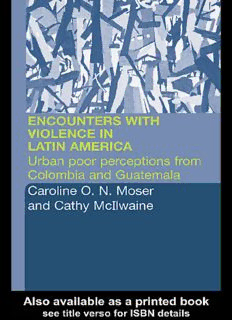
Encounters with Violence in Latin America: Urban Poor Perceptions from Colombia and Guatemala PDF
Preview Encounters with Violence in Latin America: Urban Poor Perceptions from Colombia and Guatemala
ENCOUNTERS WITH VIOLENCE IN LATIN AMERICA Latin America is both the most urbanized and the most violent developing region, where the links between social exclusion, inequality, fear and inse- curity are clearly visible. The banal, ubiquitous nature of drug crime, robbery, gang and intra-family violence destablizes countries’ economies and harms their people and social structures. Encounters with Violence in Latin America explores the meaning of violence and insecurity in nine towns and cities in Colombia and Guatemala to create a framework of how and why daily violence takes place at the community level. It uses pioneering new methods of participa- tory urban appraisal to ask local people about their own perceptions of violence as mediated by family, gender, ethnicity, and age. It develops a typology which distinguishes between the political, social, and economic violence that afflicts communities, and which assesses the costs and con- sequences of violence in terms of community cohesion and social capital. This gives voice to those whose daily lives are dominated by widespread aggression, and provides important new insights for researchers and policy-makers. Caroline O.N. Moseris a social anthropologist and social policy specialist. She is currently Senior Research Associate at the Overseas Development Institute and Adjunct Professor at the New School University, New York. Her publications include Gender Planning and Development (1993) and Victims, Perpetrators or Actors?(with Fiona Clark, 2001). Cathy McIlwaine is Senior Lecturer in the Department of Geography, Queen Mary, University of London. She has co-authored and co-edited Women of a Lesser Cost (with Sylvia Chant, 1995) and Challenges and Changes in Middle America(with Katie Willis, 2002). ENCOUNTERS WITH VIOLENCE IN LATIN AMERICA Urban poor perceptions from Colombia and Guatemala Caroline O.N. Moser and Cathy McIlwaine First published 2004 by Routledge 29 West 35th Street, New York, NY 10001 Simultaneously published in the UK by Routledge 11 New Fetter Lane, London EC4P 4EE Routledge is an imprint of the Taylor & Francis Group This edition published in the Taylor & Francis e-Library, 2004. © 2004 Caroline O.N. Moser and Cathy McIlwaine All rights reserved. No part of this book may be reprinted or reproduced or utilized in any form or by any electronic, mechanical, or other means, now known or hereafter invented, including photocopying and recording, or in any information retrieval system, without permission in writing from the publishers. Library of Congress Cataloging in Publication Data A catalog record for this book has been requested British Library Cataloguing in Publication Data A catalogue record for this book is available from the British Library ISBN 0-203-64635-5 Master e-book ISBN ISBN 0-203-67319-0 (Adobe eReader Format) ISBN 0–415–25864–2(Print Edition) TO THE NEXT GENERATION OF PEACEFUL YOUNG MEN, TAGE, MAX AND SAVVA CONTENTS List of figures ix List of tables xiii Acknowledgments xiv 1 Urban violence as a contested domain 1 2 Toward a policy-relevant positioning of violence: the role of participatory research methodologies 20 3 The multiple complexity of daily violence in urban Colombian and Guatemalan communities 40 4 Community perceptions of the structural factors underlying political and economic violence 65 5 The family as a violent institution and the primary site of social violence 99 6 Substance abuse-linked violence relating to drug and alcohol consumption 117 7 Organized violence at the community level 137 8 Violence, social institutions and social capital in communities 156 9 Avoiding or confronting violence? Community perceptions of strategies and solutions 178 vii CONTENTS Appendices 197 Notes 234 Bibliography 243 Index 262 viii FIGURES 2.1 Colombia: locations of towns and cities where the research was conducted 29 2.2 Guatemala: locations of towns and cities where the research was conducted 30 3.1 Types of violence and danger in Villa Real, Esquipulas, Guatemala 47 3.2 Listing of violence and insecurity in El Arca, Cali, Colombia 48 3.3 Causal flow diagram of types of violence in La Merced, Guatemala City 49 3.4 Drawing of ‘what are you afraid of?’ in El Arca, Cali, Colombia 51 3.5 Onion diagram of problems in Sacuma, Huehuetenango, Guatemala 54 3.6 Map of dangerous places in El Arca, Cali, Colombia 58 3.7 Map of dangerous areas in La Merced, Guatemala City 59 3.8 Causal flow diagram of intra-family violence and insecurity in Amanecer, Bucaramanga, Colombia 64 4.1 Framework for analyzing everyday urban violence 67 4.2 Causal flow diagram of violence in Colombia Chiquita, Aguazul, Colombia 70 4.3 Causal flow diagram of the relationship between intra- family violence, violence between neighbors and violence over land in Colombia Chiquita, Aguazul, Colombia 72 4.4 Drawings of guerrillas in El Arca, Cali, Colombia 75 4.5 Causal flow diagram of the effects of the armed conflict in La Merced, Guatemala City 76 4.6 Depiction of the government, Jericó, Bogotá, Colombia 79 4.7 Diagram of institutional links of the Casa de Justicia (House of Justice) in Amanecer, Bucaramanga, Colombia 80 4.8 Diagram of the function of the Casa de Justicia(House of Justice) in Amanecer, Bucaramanga, Colombia 80 ix
Description: